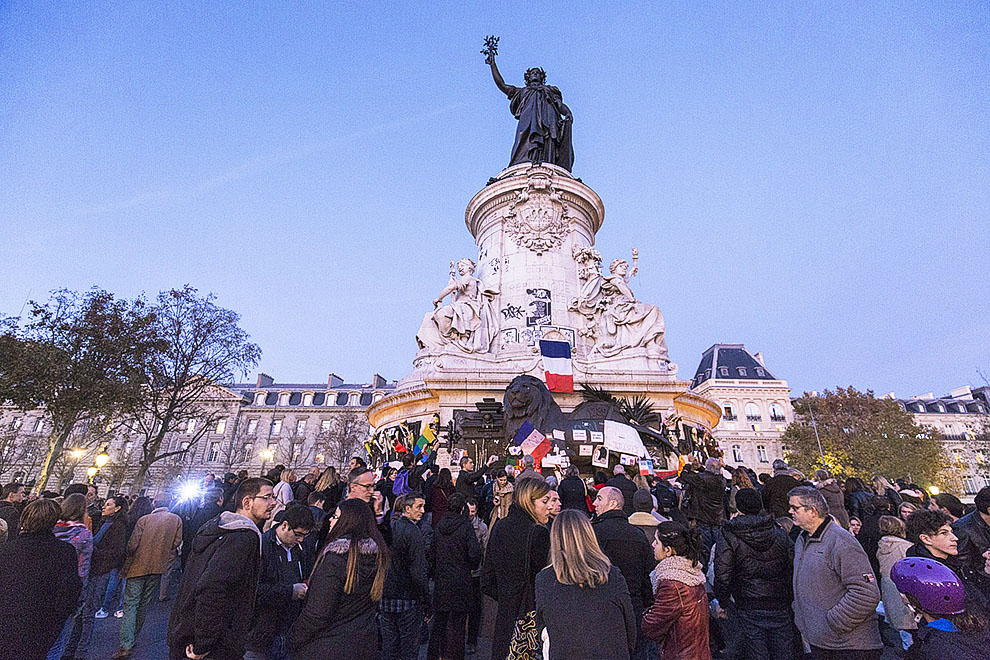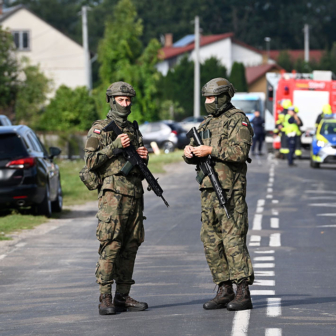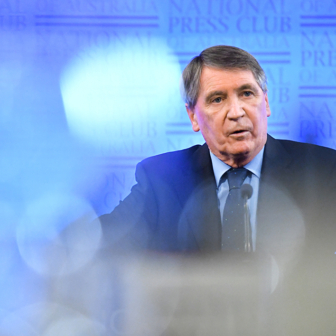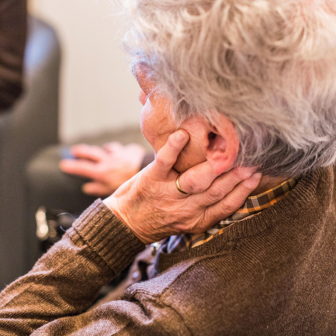“The bomber will always get through.” In the deep valley of the 1930s, a phrase used by the British conservative politician Stanley Baldwin came to stand for the sense of foreboding with which beleaguered European democracy envisaged the prospect of another war. Today, after the latest massacre of innocents in Paris by a jihadi cell, it is hard for many citizens of France and its neighbours to escape the same mix of pessimism and fatalism.
So unequal were the odds on that convivial Friday evening, so “easy” the targets in the restaurants and clubs where young Parisians were gathering, and so infinite the opportunities presented by open societies to those intent on killing without discrimination or restraint: no wonder that the outpouring of grief and solidarity following the events of 13 November has been shadowed by a “fear of the future” of the kind expressed by Baldwin in 1932. By shell-shocked Saturday, when the unleavened horror of the night before was becoming plain, the bleakest thought of all (to adapt Albert Camus) was that those in the grip of a nihilistic ideology will always “get through” to kill and die in a happy city.
In this respect the response in France is already a contrast with that following the murders in January of seventeen people at the satirical magazine Charlie Hebdo and at a Jewish kosher supermarket, when hundreds of thousands marched behind an array of world leaders under the rubric “Nous sommes tous Charlie” (“We are all Charlie”). It’s not just that France’s state of emergency prevents any such major show of unity in the historic Place de la République, though a few hundred did gather there for a candlelit vigil on Saturday night, and another gathering took place on Sunday. This time, the mood is more inward. The difference owes something to the amorphous nature of the assaults, the normality of their setting, their vaster scale, and the intimate, “they-are-us” character of the 132 killed and 350 wounded. (The former total rose by three on 15 November as emergency hospital treatment wasn’t enough to save them.)
The events unfolded in a confusing sequence that took hours for authorities and reporters to piece together. Soon after 9 pm local time, five black-clad operatives made near simultaneous raids in Paris’s bustling 10th and 11th arrondissements. Shootings at a bar, Cambodian restaurant, pizzeria and street near the Place de la Republique killed thirty-nine people in all, while an incursion into the Bataclan concert hall in Boulevard Voltaire (where an alternative rock music band was performing) left ninety dead. Near simultaneously, three companions exploded their suicide vests outside the Stade de France in the city’s north, where France and Germany were playing a friendly soccer match. (They may have aimed to enter the stadium and inflict much greater carnage; at least one had a ticket but was stopped from entering by guards employed by Perth-based MCS Security.)
France’s president, François Hollande, had been hurriedly evacuated from the stadium as the explosions sounded. Within two hours he was announcing the emergency, including a closure of national borders, on television. Three days of official mourning have followed. Across the city and Europe entire, front pages were frantically rewritten and news channels went into rolling coverage of still inchoate fragments. Soon, expressions of sympathy from world leaders were pouring in, along with now customary symbolic gestures: Sydney’s Opera House and London’s Tower Bridge lit in the French tricolour, Barack Obama’s reference to “our oldest ally,” spontaneous vigils and renderings of “La Marseillaise” outside diplomatic missions. France’s universalism, as well as being integral to national identity, still carries global appeal.
Yet this time, the aftermath will inevitably demand much more: more thought, leadership, international cooperation and cohesive purpose. In retrospect, the January massacre, and the thwarted attack on an Amsterdam-to-Paris train in August, became too symbolic too quickly. “Black Friday” may prove the real catharsis for France and perhaps beyond, by clarifying the historic scale of the Islamic State, or ISIS, challenge. What, however, might more vigorous “securitisation” do to the very liberty ingrained in the Parisian, and French, soul? Here, many cite Britain’s ubiquitous CCTV as the regrettable price, or a too high one, for notionally greater security. It is not only that there are no easy answers; in diverse Europe there may be no uniform ones either.
In any event, the authorities’ immediate priority is to map the exact details of what happened and its background, in order to assess and counter live risks. Most urgent is to track the links between what the security agencies call the “point of origin” and the “point of connection”: in this case perhaps Raqqa, the ISIS “capital,” and Paris. Evidence that the perpetrators include three French brothers – now respectively dead, detained and on the run – give the investigation momentum, as do the arrests of suspected associates near Brussels. Other reports, of a Syrian and an Egyptian passport belonging to attackers, and of connections (including arms transfers) with the refugee inflow through Greece and the Balkans, have yet to cohere.
The testimony of survivors, often underestimated, is also invaluable at this stage. Amid their trauma, several confirm the unmasked assailants’ clinical approach, youthful appearance, and calm reloading of weaponry. One referred to a “ghostly” enemy who seemed to appear from nowhere to casually mow down people sitting outside at a restaurant table. The prominent French writer Pascal Bruckner echoes the observation: “We are living in a state of war – a special war with invisible enemies striking at us whenever they want.”
The location, timing and horror of the atrocity ensure its worldwide impact. In turn that gives a crucial insight into the minds of those who planned it. In perspective, Paris represents an epicentre of Islamist terror since the mid 1990s (when a wave of bombings struck the city, killing eight people on its rail network). The bloodbath of relaxed youngsters on a night out recalls Bali’s nightclub bombing in October 2002, where ninety-one Australians were among the 202 dead (as does ISIS’s rhetoric in claiming responsibility – Paris as the “capital of prostitution and vice, carrier of the Banner of the Cross of Europe”). Turning victims into hostages, as for several terrible hours at Bataclan before police stormed the venue, has a trace of the Chechen sieges in Moscow and Beslan in the early 2000s.
The intended targeting of the Stade de France echoes the “spectacle” of 9/11 itself. A major strike on a European capital links to the bombings of Madrid’s and London’s transport hubs in 2004–05. Above all, the mobile, marauding assaults that turned the freedom of the city against itself – as an opportunity for large-scale murder – closely resemble the Mumbai operation of November 2008 (directed from Pakistan), where a ten-man cell killed 166 people.
Along with the explosion on a Russian passenger jet over Sinai, and other recent massacres in Tunis, Ankara, Baghdad, and Beirut (to name only those), ISIS has developed the capacity to apply al Qaeda’s hybrid killing strategy in a more professionally militarised way. The French scholar Jean-Pierre Filiu, author of From Deep State to Islamic State, calls the movement “a successful al Qaeda able to coordinate major terrorist attacks worldwide.”
It is the Mumbai precedent that most worries British emergency planners, who rehearsed just such a scenario in June. Raffaello Pantucci, author of We Love Death As You Love Life: Britain’s Suburban Terrorists, says that the “form of horror” displayed in Paris “requires deep indoctrination, preparation and training… Mumbai-style terrorism has reached European shores.”
Many would-be assaults in Britain have already been aborted at the planning stage by good intelligence, or even a later one by luck and heroism. In June 2007, a Bali-type attempt on a nightclub in London’s Leicester Square, followed the next day by a ram-raid bombing of Glasgow airport, both narrowly failed. Everyone in Britain’s “deep state” is inculcated in the chilling reminder from the Irish Republican Army, or IRA, after it killed five people, but just missed Margaret Thatcher, in Brighton in 1984: “We only have to be lucky once.”
Much concern focuses on the approximately 750 young British Muslims who have gone to Syria to join ISIS, of whom around 450 have since returned. Both returnees and stay-at-home sympathisers are subject to what Charles Farr, head of the Office for Security and Counter-Terrorism, calls “ideological grooming” by ISIS’s cyber-caliphate propagandists. Monitoring and deradicalisation programs race to stay ahead. A timely New Statesman analysis by Shiraz Maher of London’s International Centre for the Study of Radicalisation – published on the day of the Paris attacks – notes that the ISIS threat “is diversifying, deepening and becoming ever more sophisticated.”
The Independent’s Patrick Cockburn developed the point in the wake of the massacre. ISIS “is an effective fighting machine because its military skills… are a potent blend of urban terrorism, guerrilla tactics and conventional warfare.” Its ends, moreover, are clear: to entice Western states further into direct combat via “boots on the ground,” and to foment sectarian hatreds in the West that reinforce alienation among local Muslims and thus make them more receptive to the jihadi message.
One lesson of Paris is the need for world leaders – now meeting in the G20 summit in Antalya, Turkey – to have a coherent strategy whose various elements (political, military, intelligence, hard and soft power alike) emerge from a definite analysis and are tied to a desired result. Stopping criminal violence and its triggers is the vital, day-to-day priority, a whack-a-mole task but not in itself a strategy. The latter has to be linked to democratic renewal, social harmony and economic progress in ways that link Europe, the Middle East and other regions. Above all, the strategy needs what is sorely lacking today: confidence in the West’s own best principles.
There is little sign of this emerging. And Europe’s margin of freedom, as Nick Cohen wisely counsels in the Observer, may be shrinking. (After Paris, he writes, “it feels as if our luck has run out.”) But a small consolation is that an economically straitened Europe, now very pressed too by a huge refugee and migrant inflow, for the moment resists the intercommunal strife longed for by jihadi and other extremists. Paris’s response to the trauma of “13/11,” necessarily less demonstrative than after the Charlie Hebdo atrocity, is so far equally noble.
The Sunday Times journalist Patrick Bishop, now resident in the city’s northwest, talks to Ammar, the manager of a shoe shop, who says, “Everyone knew this was coming… It takes a certain type of person to set out to kill people when they are having a good time – eating, drinking, watching a band. It shows how much they hate life and want to destroy it.” But is there a chance they will succeed? “Never! I am an Algerian and a Frenchman and a Muslim and proud to be all three. I live here in friendship with my neighbours, Jew, Catholic, whatever. What has happened is dreadful, but we Parisians will sort ourselves out and get on with life and its pleasures. We’ve got to. Otherwise the terrorists have won.”
It’s a fragment among millions. And there is so much the other way. But each fragment, like each destroyed and wounded life, matters. Paris’s sadness is a measure of the beautiful humanity it and the world has lost. Those lives of hope and promise must somehow hold the key to a future beyond fear. •




